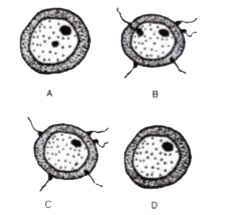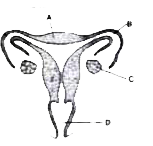(a) In which part of the human female reproductive system do the following events take place ?
I-Release of 1st polar body
II-Release of 2nd polar body
III-Fertilisation
IV-Implanatation
(b) From where do signals for parturition originate and what does material pituitary release for stimulating uterine contrations for child birth ?
Step-by-Step Solution:
1. Release of 1st Polar Body:
- This event occurs in the ovary. The first polar body is released after the completion of the first meiotic division of the oocyte.
2. Release of 2nd Polar Body:
- This occurs in the fallopian tube. The second polar body is released when the sperm fertilizes the secondary oocyte.
3. Fertilization:
- Fertilization takes place at the ampullary-isthmic junction of the fallopian tube, where the sperm and the oocyte meet.
4. Implantation:
- Implantation occurs in the uterus. The fertilized egg embeds itself into the uterine lining.
(b) Answer the second part of the question regarding parturition:
1. Signals for Parturition:
- The signals for parturition originate from the fully developed fetus and placenta. These signals induce uterine contractions.
2. Hormone Released by Maternal Pituitary:
- The maternal pituitary gland releases oxytocin, which stimulates uterine contractions during childbirth. Oxytocin is often referred to as the "birth hormone."
- This event occurs in the ovary. The first polar body is released after the completion of the first meiotic division of the oocyte.
- This occurs in the fallopian tube. The second polar body is released when the sperm fertilizes the secondary oocyte.
- Fertilization takes place at the ampullary-isthmic junction of the fallopian tube, where the sperm and the oocyte meet.
- Implantation occurs in the uterus. The fertilized egg embeds itself into the uterine lining.
- The signals for parturition originate from the fully developed fetus and placenta. These signals induce uterine contractions.
- The maternal pituitary gland releases oxytocin, which stimulates uterine contractions during childbirth. Oxytocin is often referred to as the "birth hormone."
Topper's Solved these Questions
- BOOK - TRUEMEN BIOLOGY ENGLISHCHAPTER - REPRODUCTIONEXERCISE - SECTION-D27videos
REPRODUCTION
- BOOK - TRUEMEN BIOLOGY ENGLISHCHAPTER - REPRODUCTIONEXERCISE - SECTION-B39videos
REPRODUCTION
- BOOK - TRUEMEN BIOLOGY ENGLISHCHAPTER - Protista EXERCISE - ASSERTION AND REASON6videos
Protista
- BOOK - TRUEMEN BIOLOGY ENGLISHCHAPTER - Reproduction In OrganismsEXERCISE - MULTIPLE CHOICE QUESTION131videos
Reproduction In Organisms
Similar Questions
(a) In which part of the human female reproductive system do the following events take place?
(i) Release of 1st polar body
(ii) Release of 2nd polar body
(iii) Fertilisation
(iv) Implantation
(b) From where do signals for parturition originate and what does maternal pituitary release for stimulating uterine contractions for childbirth?View SolutionIn which parts of the body of the hosts do the following events in the life cycle of Plasmodium take place? Name both the body parts and the host. (a) Fertilisation, (b) Development of gametocytes, (c) Release of sporozoites, (d) Asexual reproduction.
View SolutionName the respective part of human female reproductive system:
(i) that produces eggs.
(ii) where fusion of egg and sperm take place, and
(iii) where zygote implanted.
(b) Describe in brief what happen to the zygote after it gets implanted.View SolutionGiven below are diagrams showing the different stages in the process of fertilisation of an egg in the human female reproductive tract.
Study the diagrams and answer the questions

(i) Arrange the letters given below each diagram in a logical sequence to show the correct order in the process of fertilisation.
(ii) Where does fertilisation normally take place? What is 'Implantation' that follows fertilisation ?
(iii) Mention the chromosome number of the egg and zygote in humans.
(iv) Explain the term 'Gestation'. How long does Gestation last in humans ?
(v) Draw a neat, labelled diagram of a mature human sperm.View Solution(a) Draw a diagrammatic sectional view of the female reproductive system of human and label the parts
(i) where the secondary oocytes develop
(ii) which helps in collection of ovum after ovulation
(iii) where fertilization occurs
(iv) where implantation of embryo occurs.
(b) Explain the role of pituitary and the ovarian hormones in menstrual cycle in human females.View Solution(a) Draw a diagrammatic sectional view of the female reproductive system of human and label the parts
(i) where the secondary oocytes develop
(ii) which helps in collection of ovum after ovulation
(iii) where fertilization occurs
(iv) where implantation of embryo occurs.
(b) Explain the role of pituitary and the ovarian hormones in menstrual cycle in human females.View SolutionGiven below is a diagram of the reproductive system of a human female :

(i) Name the parts numbered 1-6.
(ii) Normally after how many days does an ovary release an egg?
(iii) Where are the sperms released during coitus?
(iv) What do the sperms do after being released ?
(V) What is the function of the organ numbered 5 ?
(vi) How many days does it normally take from the fertilisation of the egg up to the birth of the baby?View SolutionWhich of the following statements about he female reproductive system are true (+) or false (-)?
1. Both FSH and LH are necessary for ovulation to take place.
2. Oestrogen tends to inhibit the production of FSH by the anterior pituitary gland.
3. Fertilization of the ovum by the spermatozoa normally takes place in the uterus.
4. Progesterone production is largely under the control of LH
5. Throughout the part of the menstrual cycle that follows ovulation, there is a slight rise in body temperature.View SolutionStudy the diagram given below and then answer the questions that follow :

(i) Name the part labelled A. Name any two hormones produced by the part labelled A.
(ii) What happens to the part labelled B if :
(1) fertilisation takes place?
(2) fertilisation does not take place ?
(iii) Where does fertilisation occur ?
(iv) Draw a neat diagram of the human sperm as seen under high magnification and label the following parts: (a) Acrosome (b) Mitochondria.View SolutionThe figure given below represents the female reproductive system of a mammal. Parts indicated by the guidelines A to D are as follows:

(A) Uterus
(B) Fallopian tube (oviduct)
(C) Ovary
(D) Vagina
(a) Give appropriate terms for each of the following:
(i) The onset of reproductive phase in a young female.
(ii) Rupture of follicle and release of ovum from the ovary
(iii) Monthly discharge of blood and disintegrated tissues in human female.
(iv) Process of fusion of ovum and sperm.
(v) Fixing of developing zygote on the uterine wall.
(vi) The permanent stoppage of menstruation at about the age of 45 years in a female.
(b) State the functions of the (0) Placenta (ii) Amniotic fluid. [ICSE 2004, 2015]
(c) Using the symbol "X' indicates the region in the diagram where fertilisation occurs.[ICSE 2004)View Solution

